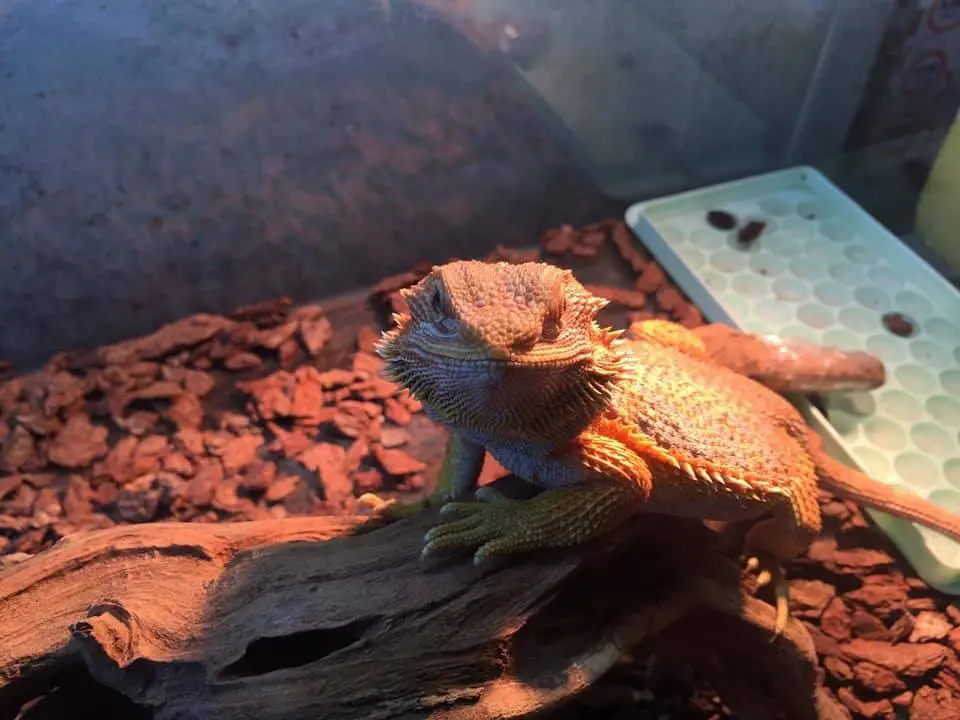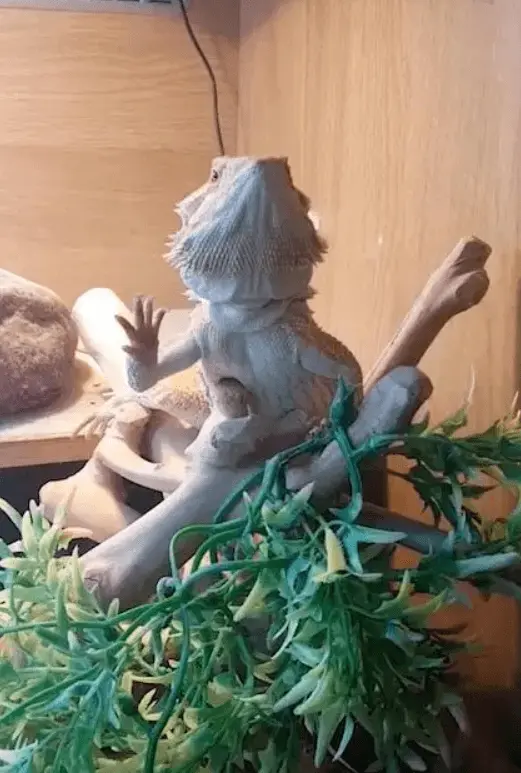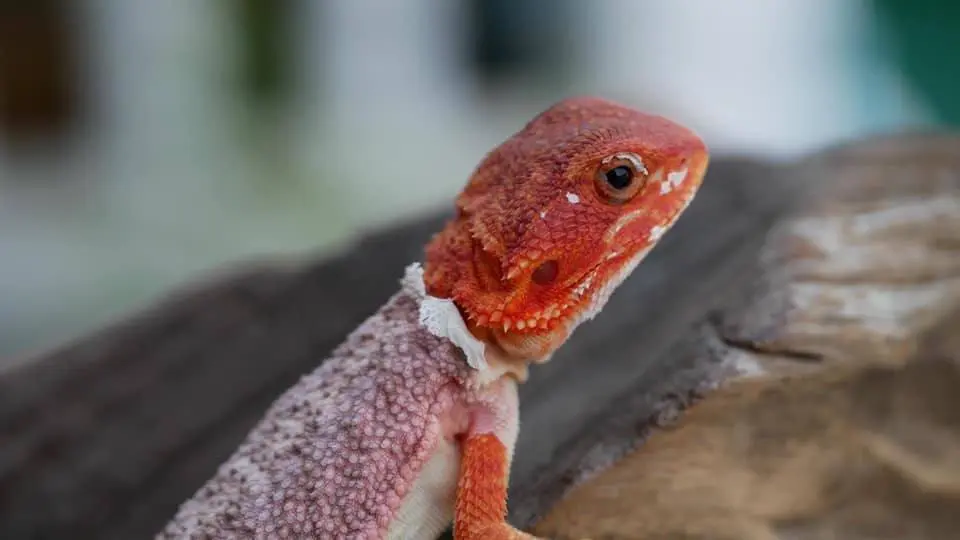Your bearded dragon will display a wide number of behaviors over the years, some are completely normal and natural, while others are unusual to say the least.
Bearded dragon behavior is related to mood, health and feelings. Behaviors can be a result of feeling threatened, a response to the environment or other dragons in the tank. Behavior can simply be related to your bearded dragons’ current mood.
While your bearded dragon cannot talk, they can communicate through body language and a variety of behaviors.
What’s Normal and What’s Not?

The first thing you need to identify is whether the behavior or body language being displayed is normal or not.
Normal behavior includes
- Head bob
- Wave
- Color change
- Mouth gaping
- Beard puffing
- Pointing tail upwards
- Basking
- Hiding
Abnormal behavior includes
- Being lethargic
- Wobbling with walking
- Lack of body movement
- Only front legs moving
- Jerky movements
- Looking upwards for no reason
Bearded Dragon Behavior And Body Language
1. Arm Waving

Often considered one of the cutest things when you arrive at the reptile store to see the baby and juvenile bearded dragons waving at you. While it looks as though they are waving in greeting, arm-waving in a beardie is actually a submissive behavior.
2. Basking
All bearded dragons will bask. They love basking in the sun, soaking up the warm rays, and absorbing the UVB radiation.
Bearded dragons can spend hours of their day under the heat lamp and UVB light bulb, it’s part of their normal daily routine. This helps them collect UVB tradition, which is essential in helping your beardie create essential Vitamin D3, helping them metabolite calcium.
3. Beard Puffing

Beard puffing is what your bearded dragon is famous for and beard puffing is a very common and natural behavior which your beardie will do when they feel threatened.
They will hold their chin up while keeping their mouth open and then they will flare their beard. As they flare the beard it will darken. It’s not uncommon for the bearded dragon to hiss at the same time. This is very aggressive behavior.
4. Brumation
Brumation is a hibernation period that some bearded dragons go through. Brumation can last a couple of days to weeks or even months. Not all bearded dragons go through brumation.
The important thing to remember is to keep your bearded dragon hydrated, as during this time they may not eat at all and if they do, it may be minimal.
Brumation includes frequent hiding, longer and more frequent naps, sluggish movements, and lack of appetite.
5. Color Changing
Changing color is another common behavior in bearded dragons. You often find your beardie will turn dark, which is often caused by temperature regulation. In addition to temperature, color-changing can also be a sign of disease or stress.
6. Digging
Digging is a very natural behavior of the bearded dragon, often done when looking for a cooler or more humid environment. Female beardies tend to dig during the daytime when they are ready to lay eggs. Female beardies will lay eggs with or without a male present.
7. Flatten Body
A bearded dragon can often be seen flattening its body against the ground. In doing so their scales look larger and sharper. This is often done to protect themselves against a predator, making them look unappealing to eat.
Some bearded dragons will flatten their body when sunbathing to increase the surface area exposed.
8. Glass Surfing
Glass surfing may look really cute as your bearded dragon looks as though they are trying to climb out of the tank, but they only glass surf when stressed.
Glass surfing may result in new decorations or a new tank mate being introduced to moving your beardie to a new tank or housing them in a habitat that they have outgrown. Glass surfing is a sign your beardie is trying to escape to a safer environment.
9. Head Bobbing
Bobbing the head up and down is a very common bearded dragon behavior, often seen when in the company of another bearded dragon. The head bobbing is used as a challenge, a warning and is considered aggressive behavior.
- Fast bobbing – Fast bobbing (with darkening beard) is often seen when you have two males in the same area. It can be a sign of territoriality and dominance and aggressive behavior.
- Slow bobbing – Slow head bobs can be a sign of submission and usually used by females.
- Violent bobbing – during the mating season, you can see your dragon bob his head violently. The bobbing can set his whole body in motion, that you may think he will hurt himself, but this is actually a way to show a ready to mate signal to the female.
10. Hissing
Hissing from a bearded dragon is a warning sign often done when they feel threatened. They will puff out their beard and hiss. This can be towards a human, especially in older dragons that have not be handled properly in the past. Be careful, a hissing adult can bite.
11. Licking / Tongue Flick
Similar to a snake, your bearded dragon will use their tongue to explore their surroundings. They have what is called a Jacobson’s Organ in the roof of their mouth which they use to taste and smell. The tongue will flick out, lick, and return to the roof of the mouth.
12. Mouth Open
Similar to a dog, your bearded dragon will keep their mouth open to control its body temperature. You will often see your beardie with their mouth open when basking. This is to prevent the risk of overheating.
If you notice that your beardie has had its mouth open for an extended period, check the temperatures inside the tank. If your beardie has their mouth open with heavy breathing, this could be a sign of a respiratory infection, and veterinary assistance is strongly advised.
13. Shedding

Shedding is completely normal behavior that all bearded dragons go through as they age. They lose their skin in pieces or chucks as they outgrow their skin.
Younger beardies tend to shed more regularly than adults with shedding lasting up to ten days. With shedding comes itching and discomfort, which can result in behavioral changes, including lack of appetite.
14. Stacking
Stacking is another common behavior. carried out by bearded dragons when you have more than one in the same enclosure. This is when the bearded dragons sit one on top of the other. This is a very common behavior in baby beardies.
While this is considered adorable, it can also be very dangerous. The beardies located at the bottom of the stack will get less UVB exposure, which is essential to their overall well-being. The added weight of the beardies on top of them can also have a negative impact on their breathing, due to the additional weight.
15. Yawning
You know humans yawn, you’ve probably seen your dog or cat yawn from time to time, but did you know bearded dragons also yawn? That’s right, your beardie can yawn.
Yawning does look different and often resembles hiccups. Your bearded dragon will puff out their beard a few times while opening and closing its mouth. The reason for this is unknown, but you often see it in the mornings, when your beardie has awoken from a nap.